Last Updated on: July 9, 2024
From Hollywood to Disneyland, beaches to wines, California is known for many things.
However…
What most people do not realize, especially tourists, is that it is also a great birding destination.
Whether you are into bird photography or you just want to attract birds to your California property, take the time to learn about the different species in the state.
From tiny finches to mighty raptors, there is a long list of birds in California. If you need help identifying the different bird species in the state, read on and we’ll help you get to know them better!
The Most Common Birds Of California
1. House Finch
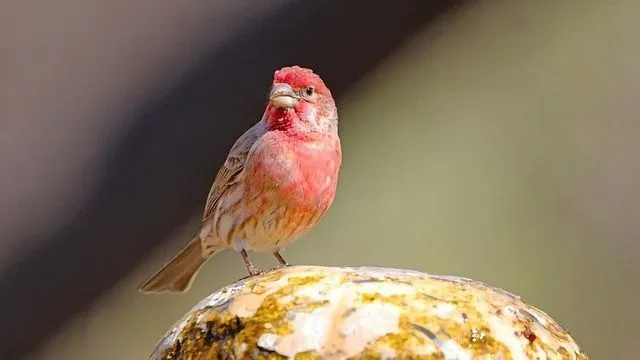
Widespread not just in California but also in other parts of North America, the house finch is a small-bodied bird with a large beak and flat head. On average, the length ranges from 5.1 to 5.5 inches while a wingspan is 7.9 to 9.8 inches.
Adult house finches have rosy-red upper breasts and faces. When flying, the red rump is visible in a male house finch. However, females are only plain gray throughout their bodies.
It is easy to attract house finches in backyards. They will visit bird feeders, especially when there is an ample supply of Nyjer seeds and black oil sunflower seeds. Both tube and platform feeders will work for these birds.
If you want to see a house finch in California, check out their natural habitats. They love open woods and forest edges. They also stay in urban centers, backyards, and city parks.
Fun Fact: The diet of a house finch influences its color. Males have red spots from carotenoids.
2. Dark-Eyed Junco

With up to 630 million dark-eyed juncos in North America, they are among the most abundant songbirds in the country. You will find them in Northern California throughout the year. However, in most parts of the state, they are only present in the winter.
The coloration of the dark-eyed junco varies depending on its location. In California, the most common is the Oregon variety. It has white outer tail feathers, a pale chest, a brown back, and a black head. Females are duller, often gray throughout the body.
The dark-eyed junco hops and runs on the ground when it is foraging. It can also scratch its feet when it is walking through snow or leaf litter.
As for their diet, dark-eyed juncos eat seeds and insects. You can lure them into bird feeders with cracked corn, Nyjer seeds, black oil sunflower seeds, and millet. You can scatter their food on the ground or put them in platform feeders.
3. California Scrub-Jay
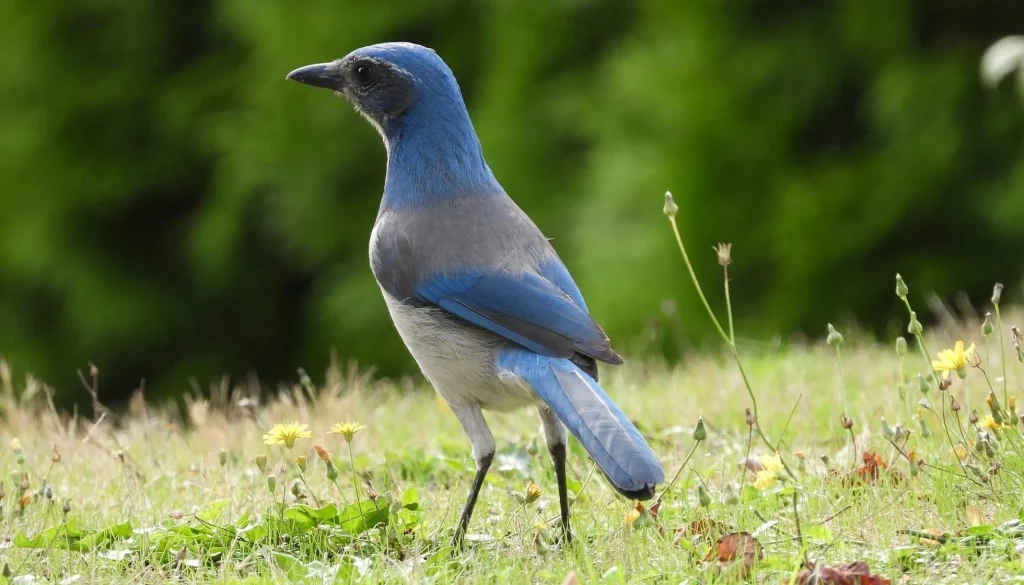
The striking blue color of the tail, head, and back is one of the first things that you will notice in this common backyard bird in California. It also has blue feathers around the neck, which look like a necklace.
With a length of 11 to 12 inches, the California scrub-jay is smaller than an American crow but larger than a western bluebird. The wings, meanwhile, can span 15.3 inches.
You will find the California scrub-jay throughout the year in coastal, central, and northern California, especially in oak woodlands. However, they are less common in southern California.
In the cooler months, the California scrub-jay can come to backyards with oak trees since they like acorns. Meanwhile, in the warmer months, they like fruit-bearing trees.
4. Red-Winged Blackbird
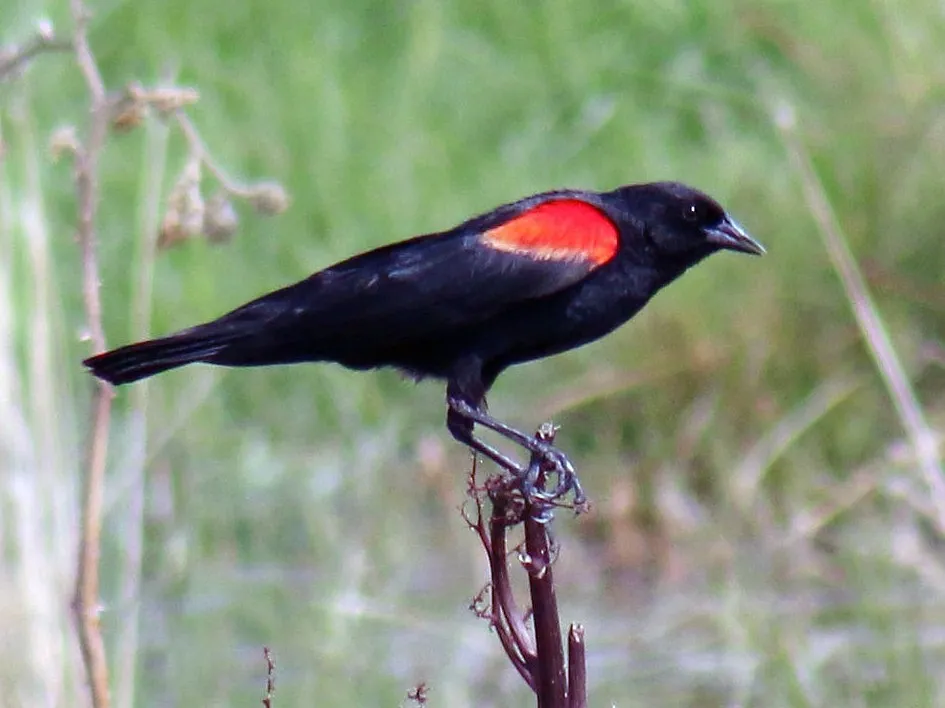
It is easy to identify birds from this family. Look for the all-black coloring in the body with a red-orange patch on the wings. Females, meanwhile, are duller compared to males. Other physical features of the red-winged blackbird include the medium-length tail, conical bill, and hump-backed silhouette when it is perched.
A male red-winged blackbird is known for doing almost anything to lure a mate during the breeding season. It will belt out a loud song throughout the day. Those who want to see red-winged blackbirds in California should visit salt and freshwater marshes. They are also abundant on wet roadsides and water hazards on golf courses.
Even in backyards, it is common to see a red-winged blackbird. They like large platforms and tube feeders, especially those with mixed seeds and grains.
5. Song Sparrow

These backyard birds are present in California throughout the year. Although, song sparrow sightings are a bit more common in the summer than in the winter.
Looking at their bodies, song sparrows are not as remarkable as the colors of other birds on this list. They have dominant brown streaks throughout their body. The song sparrows along the California coast can be darker with heavier streaks.
If song sparrows are on your bird-watching list in the Golden State, then the best places to visit are open habitats, including forest edges and overgrown fields. It is also usual for the song sparrow to visit backyards, especially when you have bird feeders with mixed seeds. The song sparrow can also eat different insects, such as caterpillars, wasps, and ants.
6. Oak Titmouse

Identifying the oak titmouse can be quite difficult. They are plain gray birds. One of their defining characteristics is the crest on the head, but they are often low, so they are not always visible.
The name will already give you an idea of where it resides in California. They are most abundant in places with oak, including woodlands and forests. Nonetheless, they can also come to nest boxes in backyards. Increase the chances of luring these birds into your property by having a feeder with black sunflower seeds.
7. American Robin
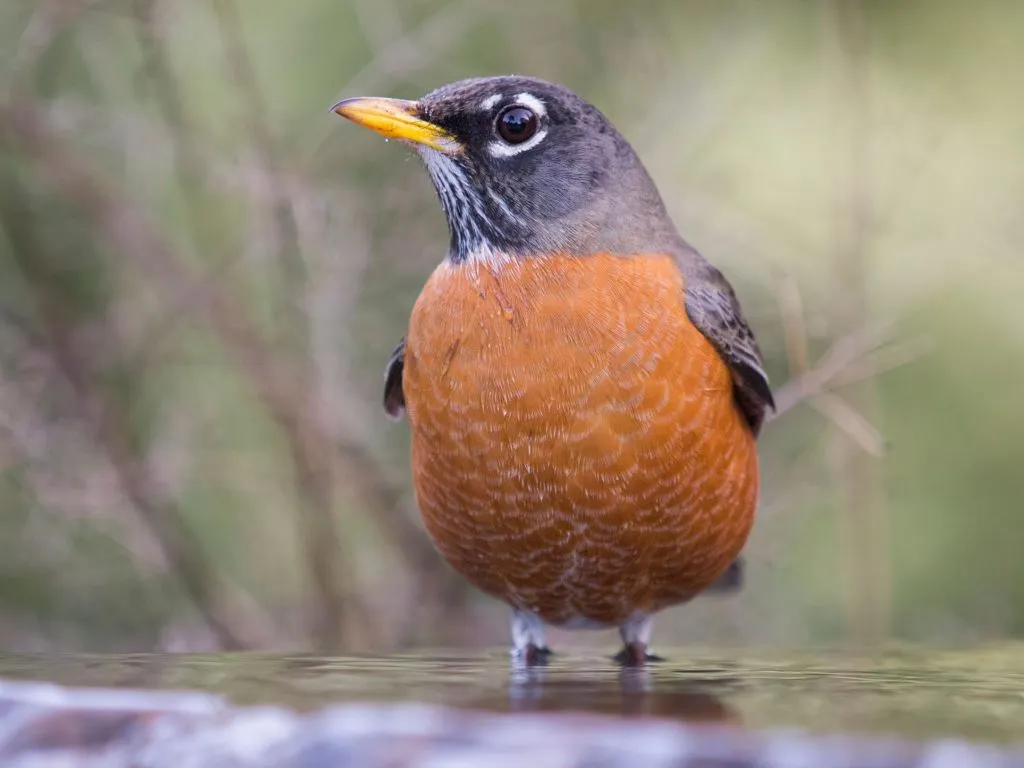
You will often find American robins on private lawns. They will rummage through the ground looking for earthworms, which form the majority of their diet. The American robin can also eat insects and berries.
To identify these birds, look for their yellow beaks and round orange bellies. It is also possible to detect their presence by listening to their calls. They are vocal singers and can be heard from dawn to dusk.
Planting native plants, such as dogwood, sumac, and hawthorn is one of the best ways to attract an American robin to your yard. In the winter, you will see American robins in massive flocks. They will congregate around their food sources.
8. Mourning Dove

A graceful bird with a slender tail, the mourning dove resides in The Golden State throughout the year, especially in the breeding season. It is easy to know when there is a mourning dove in the area. It makes a sad cooing, which appears like it is mourning.
In terms of coloration, mourning doves have soft brown bodies with black wing spots. The weight ranges from 3 to 6 ounces with males being slightly heavier than females. Meanwhile, the length of the mourning dove is anywhere from 9.1 to 13.4 inches.
Those who are looking for mourning doves can find them perching on telephone wires. On the ground, they will forage for seeds. Mourning doves also visit platform and ground feeders with cracked corn, peanut hearts, and black sunflower seeds.
9. House Sparrow

It was in the 1800s when house sparrows were first introduced in New York. Since then, they spread like wildfires, and are now some of the most common backyard birds in California. The house sparrow has brown and gray heads and white cheeks. Their bellies are gray while their backs are brown and black.
Seeds and grains are the most common food of these brown birds. They can also eat discarded food. The house sparrow can also visit bird feeders with different types of seeds.
House sparrows, like European starlings, are invasive species. Most people consider them pests, so you can legally trap and kill them in humane ways.
10. Yellow-Rumped Warbler

The coloration of these backyard birds can differ depending on their location. In California, the most abundant yellow-rumped warbler is known as the Audubon, which has a bright yellow throat, rump, and sides. Females have duller bodies with markings that are less pale than those you will find in males.
In the southern half of California, yellow-rumped warblers are more frequent in the winter. Meanwhile, you will see the yellow-rumped warbler throughout the year in the northern parts of the state in the spring and summer, which is where they breed.
Coniferous forests are the most common habitats of yellow-rumped warblers. In the winter, they are in places with fruiting shrubs. In the summer, yellow-rumped warblers eat mostly insects, including weevils, crane flies, grasshoppers, and ants.
11. Golden-Crowned Sparrow
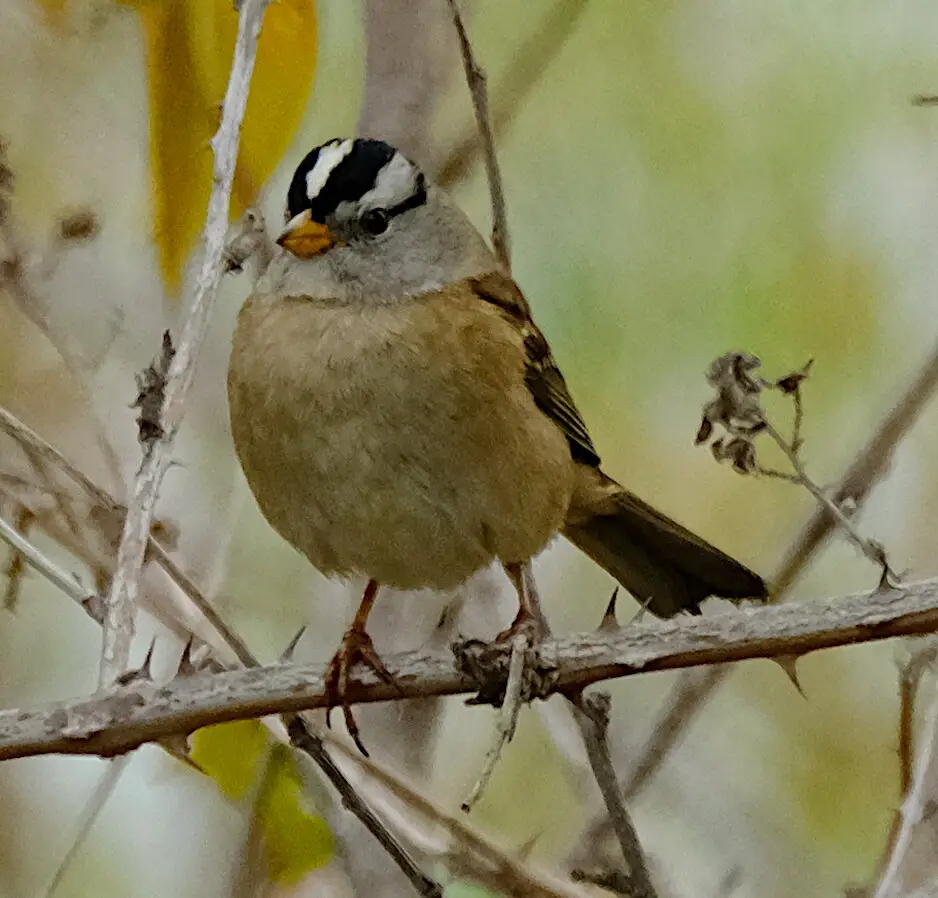
Typical of sparrows, these California birds have gray bodies with black, white, and brown streaks. You can differentiate them from others through their dark black cap with a yellow spot in the center.
You will see golden-crowned sparrows in California only in the fall and winter. They are most prominent in the state’s western and northern portions.
The natural habitats of golden-crowned sparrows include weedy fields with geranium, sumac, and dock. They are also common in places with olives, elderberry, grapes, and apples.
While the golden-crowned sparrow will eat bird seeds, they love feeding on the ground. So, if you want them in your backyard, you need ground feeders.
12. Cooper’s Hawk
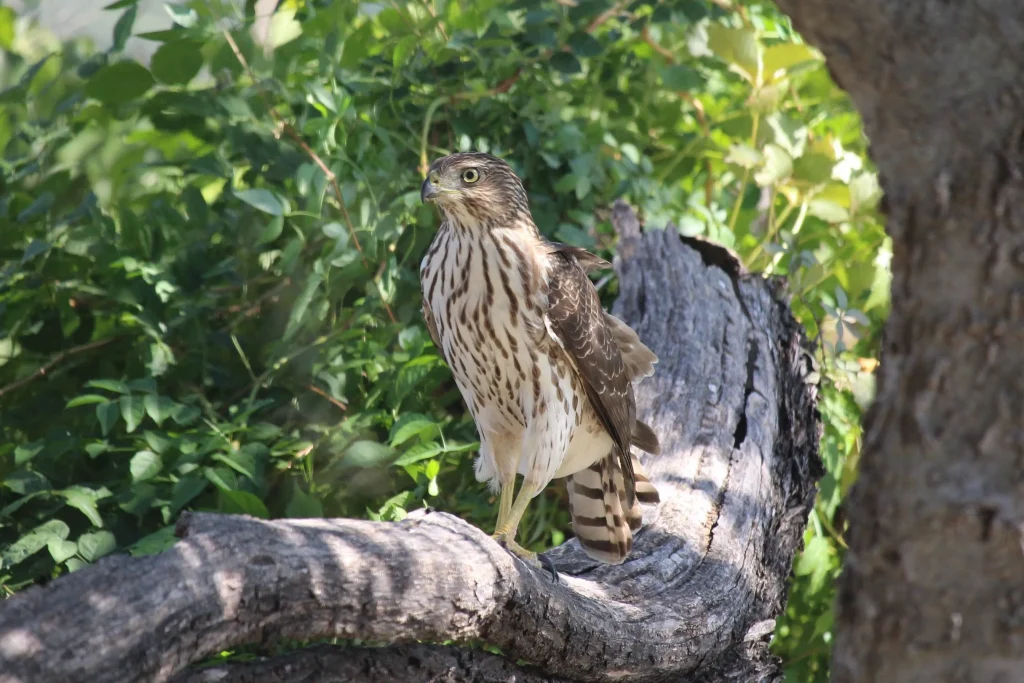
California is also home to several birds of prey, and one of the most common is the cooper’s hawk. These medium-sized birds have very long tails and rounded wings, which are typical in an accipiter.
An adult cooper’s hawk has a blue-gray upper body with light red bars on its underparts. It also has a thick dark band on the tail feathers. In-flight, cooper’s hawks make flap-flap-glide patterns. They do not flap continuously, especially when they are soaring in open areas.
Some of the preferred habitats of these raptors include open woodlands, mature forests, river groves, and wood edges. The diet of the cooper’s hawk includes small birds and mammals. It will eat flickers, jays, ground squirrels, chipmunks, bats, and mice.
13. Cedar Waxwing

A sleek and medium-sized bird, the cedar waxwing has a wide bill, short neck, square-tipped tail, and large head. It also has a crest that lies flat and drops to the back of its head.
For its coloration, cedar waxwings are light brown from the head to the chest transitioning into soft gray approaching the wings. There is a black mask on the face with a thin black outline.
Cedar waxwings like to gather in flocks. They are very social. They spend most of their time sitting on the top of trees with berries. You can also find them coursing on the water as they look for insects to eat.
14. Allen’s Hummingbird
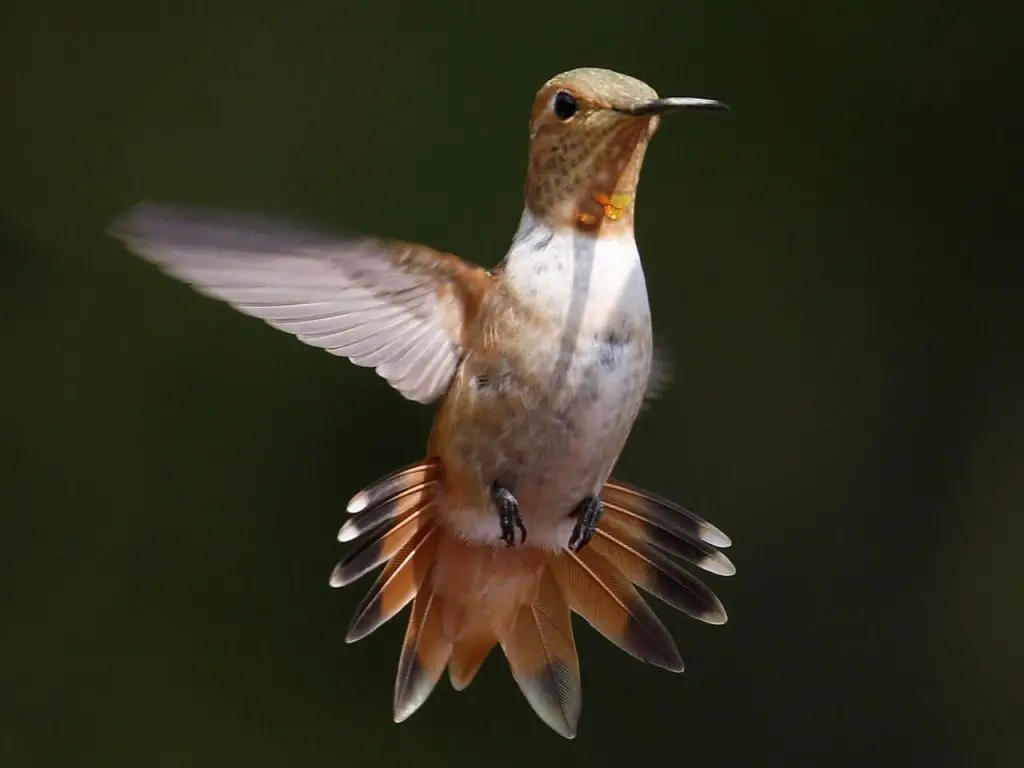
From February to July, Allen’s hummingbirds visit the coastal regions of California. In the winter, they migrate to Mexico.
They are some of the most beautiful birds that you will find on this list. They have orange eye patches, tails, and bellies. Their throats are iridescent reddish-orange. Females are bronze-green in the upper body with pale copper undersides.
You can find Allen’s hummingbirds in gardens where they zip from one flower to another. Aside from nectars, they also eat tiny insects. They can also visit hummingbird feeders with sugar water.
15. California Towhee

You will see California towhees in the Golden State throughout the year as they are non-migratory birds. However, while they are year-round residents, they are present in limited areas. Your best chances of seeing them would be in coastal chaparral scrubs. They are also in fenceposts and backyards.
The California towhee is almost all-brown throughout the body except for the rusty patch that you will find under its tail. Males and females are almost similar in terms of their appearance.
Most of its diet is seeds that the bird obtains from herbs and grasses. Nonetheless, they also eat berries.
16. Anna’s Hummingbird
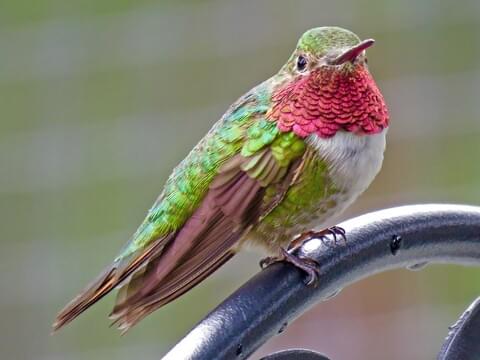
While they are more common in the winter than in the summer, Anna’s hummingbird is a year-round resident in California. With a length of only 3.9 inches on average, Anna’s hummingbird is a small bird. When it is flying, the wingspan is less than five inches.
Because of their size, seeing Anna’s hummingbird in action can be difficult. To identify these birds in California, look for their gray and green bodies. They might be tiny, but they are colorful birds.
They are not frequent visitors to bird feeders. Nonetheless, this does not mean that you cannot lure them into your backyard. The best way to attract them is to have colorful plants and nectar feeders.
17. Northern Mockingbird
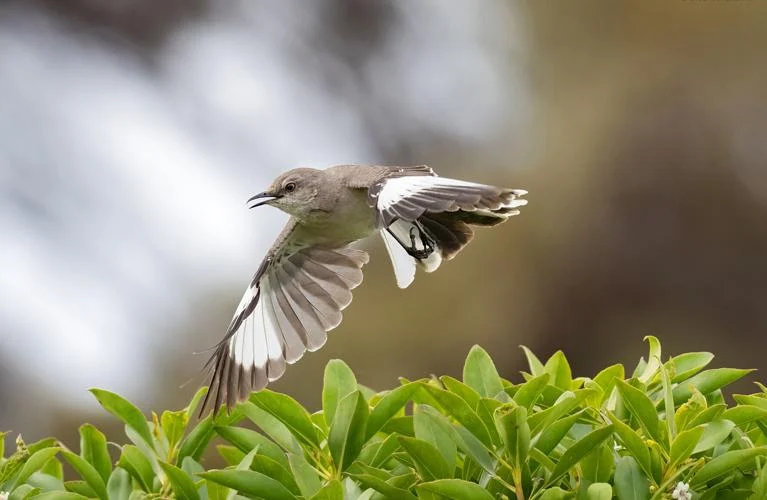
With long tails and small heads, northern mockingbirds are medium-sized. The body is mostly gray-brown. Meanwhile, the underside is duller than its back. They have two white wing bars, which are visible in flight.
The northern mockingbird does not migrate. This means that you can spot them in California regardless of the season. On the northwest border, however, they are present only in the spring and summer.
These backyard birds in California are known for their endless songs, especially during nesting season. Males can learn up to 200 songs in their lifetime.
It is common to see northern mockingbirds in the backyard, but they do not visit bird feeders. You can still lure them by having a bird bath and fruit-bearing trees or shrubs.
18. Blue Jay

If you are interested in seeing colorful birds in California, blue jays should be on your list. Their upper bodies have different shades of blue, white, and black. Underneath, they are either light gray or white.
More than being colorful, blue jays are also known for being loud. They make an array of musical sounds, including an imitation of the screams of red-shouldered hawks.
This bird is also adaptable, making it thrive in various habitats. They are also quick to attack when they see bird feeders, especially those with sunflower seeds and nuts. In the wild, blue jays live on forest edges. It is most abundant in locations with oak since they love eating acorns.
19. White-Crowned Sparrow
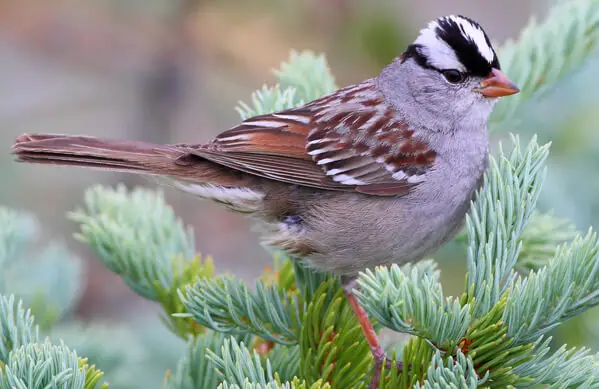
In the winter, there are frequent sightings of the white-crowned sparrow in California. They are also present in the summer but rarer than the other birds on this list.
The first thing that you will notice in a white-crowned sparrow is its pale gray color. Look closer and you will see the bold black and white stripes on the head. It also has a yellow or pale-pink bill.
Weedy fields, especially those that are on forest edges and roadsides are some of the preferred habitats of white-crowned sparrows. They are also often seen in backyards where they are foraging seeds from grasses, as well as berries. If you want to attract white-crowned sparrows in the backyard, then install bird feeders with sunflower seeds.
The white-crowned sparrow lays four to five pale-greenish to creamy white bird eggs with reddish-brown spots.
20. European Starling
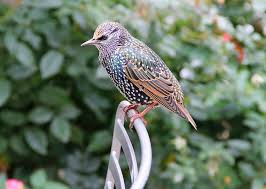
About the size of an American robin, European starlings were first seen in New York in the 1890s. After years, they became widespread and are now some of the most common birds in California.
The European starling is a stocky bird. It has blue, green, and purple tones throughout the body.
However, most homeowners do not like seeing a European starling in the backyard. They are invasive and aggressive. They have the habit of overtaking bird feeders and even killing their young.
21. Northern Flicker

The northern flicker is a large woodpecker. Its color ranges from light to dark brown with a white rump patch that is visible when it is in flight. The tail feathers and wing undersides, meanwhile, are yellow or red, depending on where the bird is from.
Northern flickers are in California throughout the year. However, in the southern parts of the state, they are more frequent in the winter.
A lot of northern flickers will spend their time on the ground. When they are perched on trees, they sit upright on horizontal branches, unlike others that lean on a trunk against their tails.
22. Say’s Phoebe
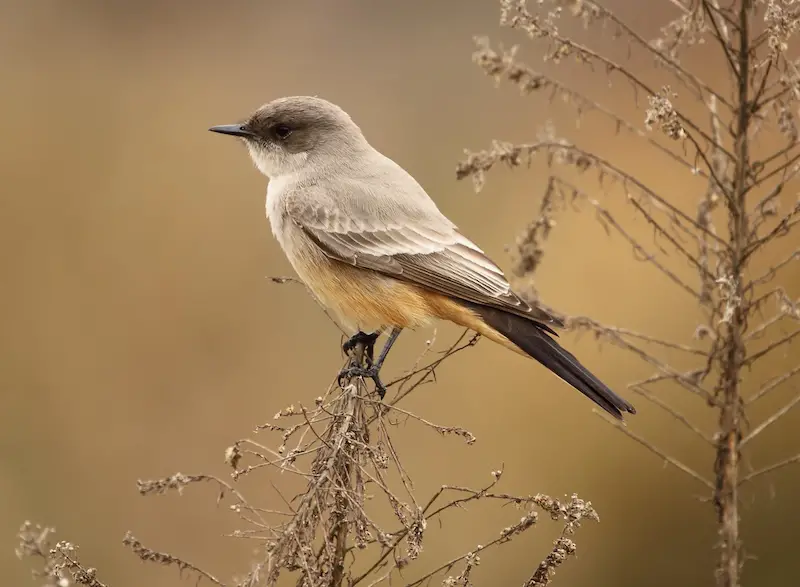
It is common to see Say’s Phoebe in California in the winter, although some of them stay year-round. These tiny birds have slender bodies and long tails. For its size, however, the head is noticeably large. The crown is usually flat, although it can be raised at times.
Like other flycatchers, the diet of say’s phoebes consists mainly of insects, including flies, bees, crickets, and beetles. Spiders, millipedes, and berries are also favorites. The most common nesting sites are buildings. They also perch on posts and around human settlements.
23. Red-Shouldered Hawk

While their population is stable year-round in California, they are not as common as red-tailed hawks. Sightings are most frequent on the state’s western coast. The most common habitats for these raptors are near bodies of water, including swamps and riverside woodlands.
Aside from the checkered wings, these birds of prey are also known for the reddish barring on their breast. The black tail, meanwhile, has white bands. Juveniles are brown on the top and white underneath with brown streaks.
More than their looks, finding red-shouldered hawks is easier by listening to their calls. They make sharp whistles, making them heard first before they are seen.
24. American Goldfinch
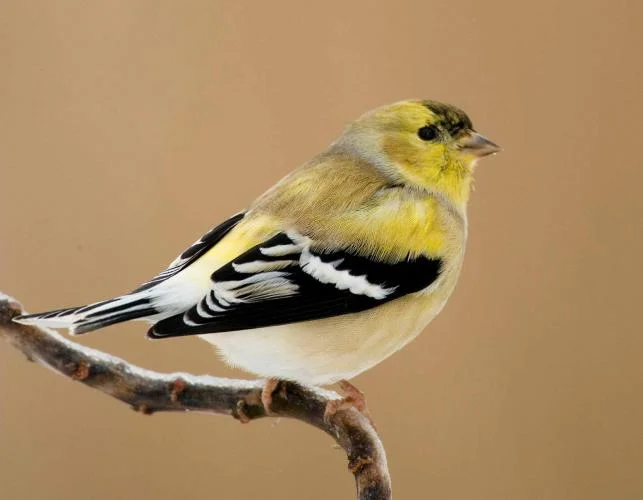
With the bright yellow plumage of American goldfinches, they are easily recognizable even from afar. They also have black wings with white markings and a black forehead. Adult females, on the other hand, have duller colors.
Even if they are small, the American goldfinch is acrobatic and active. They are bouncy in flight with undulating patterns. On the ground, they can raid bird feeders in massive flocks.
The natural habitats of American goldfinches include floodplains and woody fields. You will also see them in backyards and cultivated areas. If you want them to visit your backyard, then consider planting milkweed and thistle.
25. Chestnut-Backed Chickadee

While the chestnut-backed chickadee is a year-round resident, you won’t see them just anywhere in the state. They are most common in the coastal zones.
As the name implies, these birds have chestnut-colored backs. The head, meanwhile, has bold black and white patterns. The flanks are dark gray for those in central and southern California and rich brown for those in the north of San Francisco.
Chestnut-backed chickadees are visual treats because they are acrobatic. You can frequently see these birds hanging upside down and clinging to twigs.
Those who want to see chestnut-backed chickadees in California should go to dense and mixed coniferous forests near the coast. Nonetheless, they can also be present in parks and backyards, especially those with tube feeders, suet feeders, and platform feeders.
26. Western Bluebird
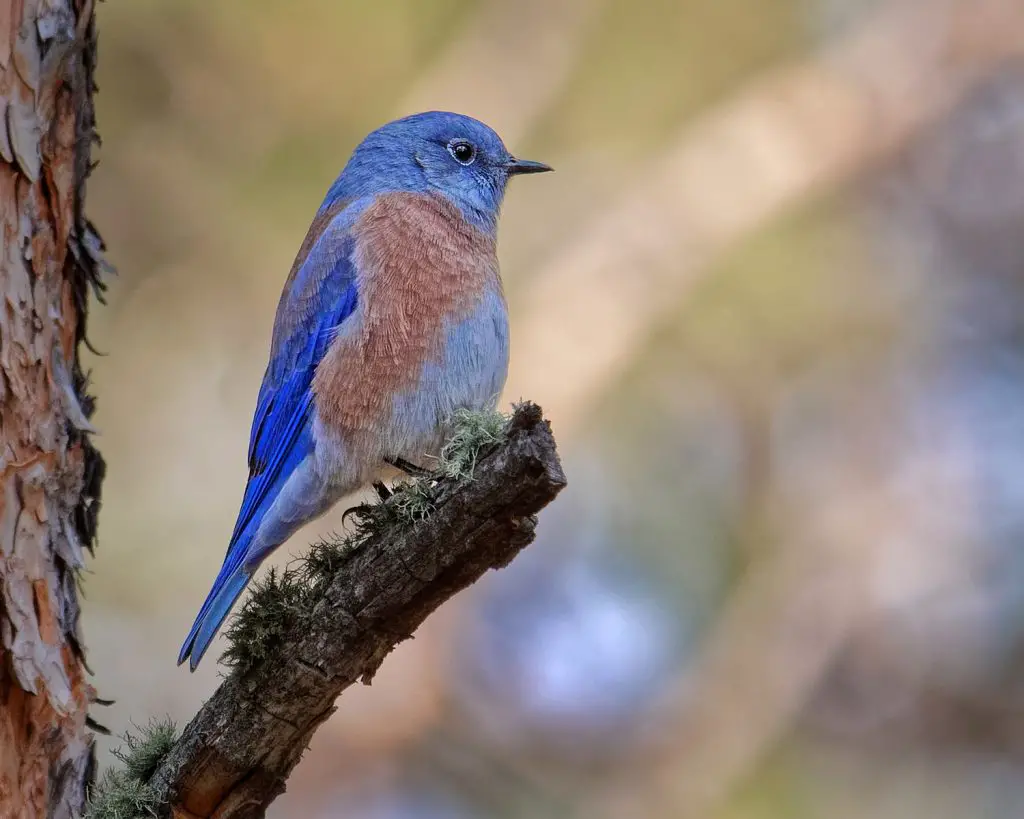
A good subject for bird photography in California, the western bluebird is colorful. Males have shiny blue upper bodies with rust orange hues from the vest to the upper back. Females are often duller but equally beautiful.
The western bluebird has a concealed crown. The red, orange, or yellow feathers are visible when they are defending their nests or themselves.
They will not visit bird feeders since they do not like to eat seeds. If you want to entice them, then the best thing to do is to have a dish or tray with mealworms.
27. Bushtit

At 2.8 to 3.1 inches, the bushtit is about the same size as a kinglet. It has a large and plump head, stubby and short bill, and a long tail. The bushtit actively forages in shrubs and trees, moving quickly among small twigs and foliage. During the nesting season, they forage in flocks.
As it hunts for food, the bushtit targets mostly insects, including caterpillars, scale insects, treehoppers, leafhoppers, and aphids. Occasionally, they also feed on seeds, berries, and spiders.
Throughout the year, bushtits are present in most parts of California, especially along the coast. Their habitats include open woodlands and scrubby areas.
28. Black Phoebe

Some of the most common physical features of the black phoebe include its squared tail, large head, and thin bill. It is sooty gray on the upper body and chest. The belly is white while the wings have pale gray edges.
The black phoebe is a year-round resident in California, although their sightings are more common in the winter. In terms of location, these birds are more abundant in the coastal areas and rare in eastern and central California.
Black phoebes are insect eaters, so do not expect them to come to bird feeders with seeds. Instead, if you want them to visit the backyard, make sure there are flies, wasps, moths, beetles, and caterpillars.
29. American Crow
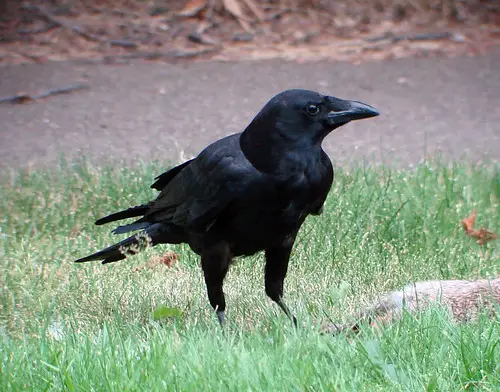
It is almost impossible to not notice an American crow when you see one. It is a large bird with long legs, a thick neck, a short tail, and a straight bill. The color is all-black. However, when they molt, their feathers can turn scaly or brownish. Meanwhile, new feathers are glossy.
American crows are known for being social birds. At times, they can form flocks of up to a thousand. They are also problem solvers and mischievous, making them good to observe.
If you want American crows in your backyard, then you will need a natural bird feeding station. They will rummage through compost. They will also eat insects, snails, small snakes, spiders, and earthworms.
Whether it is summer or winter, American crows are in California throughout the year.
30. Spotted Towhee

These tiny birds are often heard before they are seen. They are small, but it is easy to detect their presence as you can hear them scratching leaf litter in dense thickets. During nesting season, males are also noticeable because of their loud singing while on high perches.
Berries, insects, and seeds are staples in the diet of spotted towhees. In the summer, they will eat mostly caterpillars, beetles, true bugs, and moths, among other insects.
Open and shrubby habitats are places where spotted towhees thrive in California. They are also in overgrown fields, forest edges, and backyards.
31. White-Breasted Nuthatch

Even if they are small, white-breasted nuthatches are active. They climb trunks and limbs of trees as they search for food. At times, they will also feed on the ground.
Visually speaking, the white-breasted nuthatch is mostly black and gray with a white face and underparts. It has a black cap or neck, which makes it look like the bird has a hood.
Woodland edges and mature woods constitute most of its natural habitats. They also love being in deciduous stands, especially those with oak, hickory, and maple.
32. Orange-Crowned Warbler

With its name, most people will expect that it is a bright-colored bird. However, you will rarely see its orange crown. Plus, its yellow-olive body is paler compared to other warblers in the state.
When they are foraging, orange-crowned warblers frequent locations with low trees and dense shrubs. Even if they are low on the ground, spotting them can be a challenge since they are extremely quiet.
An easy way to attract them to your backyard is through hummingbird feeders with sugar water. They are also fans of suet feeders. When it comes to their diet, they eat mostly insects, such as caterpillars and flies. They can also consume some berries.
33. Ruby-Crowned Kinglet

In most parts of California, the ruby-crowned kinglet is only a seasonal visitor since it is more common in the winter. In some northern parts of the state, these birds will nest in the breeding season.
This tiny bird likes living in tall conifers, so they are tricky to spot. They have thin tails, almost no necks, and large heads. Meanwhile, their bills are straight, thin, and small. Their body is almost olive-green entirely with a white wing bar. Only males have ruby crowns, but they are not visible all the time.
Ruby-crowned winglets can visit bird feeders, especially when they have mealworms, peanuts, and sunflower seeds.
34. Lesser Goldfinch
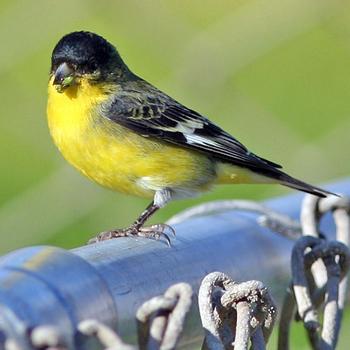
On average, the lesser goldfinch has a length of only 3.5 to 4.3 inches. Despite being tiny, however, these birds in California are notable because of their vibrant yellow bodies. They also have short, notched tails and long pointed wings. Females are often duller.
In open habitats, lesser goldfinches frequently gather in large flocks. They live in forest clearings, weedy fields, budding treetops, and even private gardens. They are more abundant in places with sycamores, willows, alders, and cottonwoods.
The lesser goldfinch will eat mostly seeds and occasionally, insects. They like seeds from the daisy family and weeds. Flowers, buds, and berries are also some of their food sources.
35. Barn Swallow
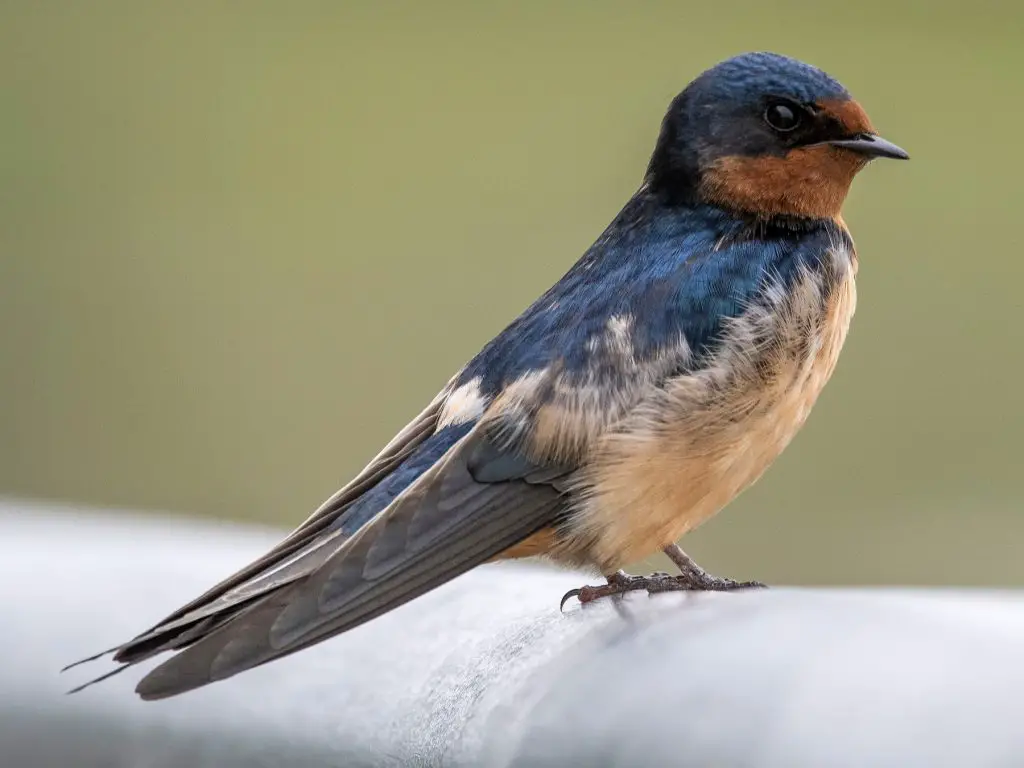
A visually striking small bird, the barn swallow has a steely blue tail, wings, and back. It has a cinnamon throat and forehead, which creates an excellent contrast to the blue face and crown. If you want to see barn swallows in your backyard, then consider adding a platform feeder with ground-up eggshells.
One of the unique characteristics of the barn swallow is its ability to feed through the wings. It uses the wings to snag insects, even from a height of up to 100 feet.
Barn swallows are territorial. They will swoop and start making alarm calls once they perceive a threat near their nests.
Watch This!
Frequently Asked Questions
What are the most common backyard birds in California?
Some of the most common backyard birds in the Golden State are house finches, blue jays, American crows, California scrub jays, northern mockingbirds, European starlings, and western bluebirds. Included in the list are the white-crowned sparrows, red-winged blackbirds, American goldfinches, and white-breasted nuthatches, among others.
How do I identify a bird in my backyard?
To identify birds in your backyard, one of the most important is to look at their physical appearance. Watch out for their colors and sizes. In most instances, males and females from the same species will have different looks. Also, observe the bird and take note of its behaviors and feeding habits.
Where can I see birds in California?
Bird watching in California is sure to be a treat. Some of the best places that should be on your list are Point Reyes National Seashore, MacKerricher State Park, Bitter Creek National Wildlife Refuge, Klamath Basin National Wildlife Refuge, Arcata Marsh, and Wildlife Sanctuary, and Yosemite National Park.
How many species of birds are in California?
According to the California Bird Records Committee, the state is home to 679 bird species. Many of these birds can come to your backyard with the right feeders while others prefer staying in the wild. Some are year-round residents while others migrate to other places.
Conclusion
With an abundance of bird life, California is one of the best places to go bird watching in North America. Even without going far, many birds can come to backyards with the right bird feeders. From their color to feeding habits, this guide looked at some of the defining characteristics of the state’s most common birds.
Are there other birds of California that we should know of? Leave a comment below and let us know.

